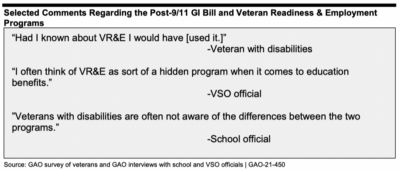As of August 2020, approximately 4.7 million veterans had a serviceconnected disability, making up about 26 percent of the total veteran population. As these veterans transition to civilian life, many choose to pursue higher education or training as a first step on a new career path. The U.S. Department of Veterans Affairs (VA) administers several benefit programs that can help veterans, including those with disabilities, pay for their education and training. The largest VA education benefit program is the Post-9/11 GI Bill (GI Bill), which according to VA provided approximately $10.1 billion in benefits to around 658,000 veterans in fiscal year 2020.
What GAO Found
Most school and veteran service organization (VSO) officials GAO interviewed stated that when given the choice between the Post 9/11 GI Bill (GI Bill) and the Veteran Readiness and Employment (VR&E) program, veterans with disabilities will base their choice on which program best suits their unique goals, preferences, and circumstances. For example, certain veterans may prefer the GI Bill’s flexibility to independently select courses of study, whereas others may prefer to have the assistance of a counselor to select a course of study as part of an employment plan, as provided under VR&E. However, most officials GAO interviewed said veterans with disabilities often use the GI Bill for education benefits without knowing that the VR&E program exists, or that it can pay for education, provide assistive equipment for their disability, or offer unique benefits of working with a counselor.

VA provides information about education benefits to veterans with disabilities through various methods, including in-person communication, online materials, and written communications. However, on the agency website, VA.gov, few webpages devoted to VR&E explicitly mention that it can help pay for a college degree. In addition, the letters that VA sends to veterans when they receive their disability rating do not specifically mention that VR&E can cover education costs for a college degree. VA’s online GI Bill Comparison Tool allows veterans to learn more about the tuition amounts each program will cover for certain schools, but it does not inform veterans on the key differences in program features across the programs. Most school and VSO officials GAO interviewed said VA’s efforts do not adequately inform veterans with disabilities about their potential education benefit options, as evidenced by the number of veterans with disabilities they encounter who are unaware that VR&E exists or who do not fully understand the benefits VR&E can provide. Including more information about how VR&E can help veterans pay for higher education, and facilitating direct comparison between the features of the GI Bill and VR&E, would help better position veterans with disabilities to choose the program that best meets their needs.
Read the whole report here:
GAO Report

